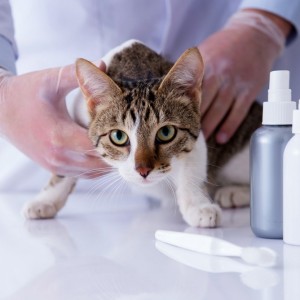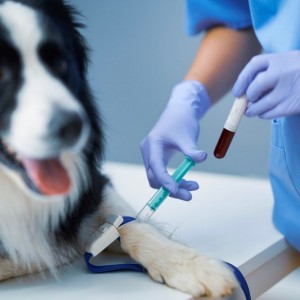March featured veterinarian: Dr. Ann Zieser, Petvivo
Dr. Ann Sherwood Zieser began her career as a companion animal practitioner at Middleton Veterinary Hospital located near Madison, Wisconsin. More than 32 years later, she continues to work at the same hospital, where she treats dogs and cats, performing diagnostics, internal medicine, radiology, surgery, and dentistry. Zieser also works as a senior technical veterinarian for PetVivo Holdings, Inc.
She served as secretary of the Dane County Veterinary Medical Association and followed a progression from vice president to president. After serving in volunteer positions within the Wisconsin Veterinary Medical Association, Zieser served as president of the state association during the pandemic. She firmly believes in the importance of community within the profession and has also held positions with the American Veterinary Medical Association. Zieser started her college career in biochemistry at the University of Wisconsin–Madison and earned a Doctorate in Veterinary Medicine from UW-Wisconsin School of Veterinary Medicine. Veterinary33 recognizes her work and dedication as our featured veterinarian of the month.
Q: How and when did you decide to become a veterinarian?
Zieser: I was one of those kids that wanted to be a veterinarian from a very early age. My first conscious thought about it was when I was seven years old. We lived out East and we were back in Illinois visiting my uncle’s farm. He had a bull with a ring in his nose and I was wearing red pants at the time. My parents and uncle were teasing me that the bull was going to charge. Their big German shepherd dog knocked me down. But rather than scare me, it made me very intrigued with animals in general. My folks didn’t share my passion. I worked on them a lot, and finally got them to get a dog for me for my tenth birthday. Her name was Shamrock since my birthday is around St. Patrick’s Day.
From there, I was focused on animals and specifically mammals, more specifically small animals. In middle and high school, I had a single-minded focus on being a veterinarian.
Q: What brought you to PetVivo, and could you talk about your career path as a veterinarian?
Zieser: When I went to college, the timing was perfect. They broke ground on the veterinary school at UW-Madison, which opened in 1983 and graduated their first class in 1987. When I started college, the vet school was in its infancy.
I went to school there for four years and focused more on small animals, but I love large animals, too. I love cows. I worked for a summer on a dairy farm, and I absolutely loved milking cows. For a year and a half, after I started vet school, I was going out handling the dairy farm one weekend a month when the farmer was working in the army reserves.
Before I graduated, I was looking for a job within the Madison area. It was not easy, but I was fortunate to find a great one. This is the same practice that I still work at now. I’ve been at that practice for over 32 years. I found a good fit and I was able to work part time while I raised my children. I have two wonderful kids.
That’s one advantage with the medical field. There’s oftentimes flexibility to raise a family without getting burnt out. I was at the clinic working as a private practitioner and the average clinician sees a lot of things: cardiology, dermatology, surgery and the list goes on.
That’s what I’ve always liked about it. No two days are ever the same. I’ve never had what I would call a desk job. Even with the work I do for PetVivo, I don’t sit at the desk too often.
I had a stint teaching in a veterinary technician program at Madison College while I was still working at the clinic as well. The PetVivo job came about through a friend in the industry who used to work with my husband, who is a territory manager in livestock animal health.
This friend was consulting with PetVivo and we talked about: How do we get general practitioners interested and educated in providing joint injections? This novel product has been approved for dogs and horses since October 2021.
Equine practitioners are much more accustomed to using joint therapies than the general population of small animal veterinarians. That conversation ended up resulting in a job offer.
I was intrigued by it and interested in doing something different. But I didn’t want to give up practice altogether. I negotiated to still be able to work parttime at the clinic. For the company it’s beneficial too. I am in practice, so I’m faced with all the challenges veterinarians experience. It’s beneficial for the company, beneficial for the clinic. It makes my life a little crazy balancing everything, but I still like to be in practice too. I can relate with other practitioners.
At first, I expressed my reservations with being in industry. But my now-colleague said: You can help a broader population of animals. I can help animals even though I am not touching them personally. That’s where it’s at for me, helping the animals and directly helping their people, too.
Q: Your title is Senior Technical Veterinarian. What’s a day in the life like at work for you?
Zieser: Being the tech service veterinarian, I’m focused primarily on getting clinical trials going, getting data about Spryng and solidifying how useful and safe it is. I was recently at Colorado State University working with Dr. Felix Duerr on a clinical trial he’s overseeing at the veterinary teaching hospital.
Another arm is going to conferences, working in the trade show and exhibit hall and educating veterinarians. I’ve always really valued and enjoyed continuing education. Being able to work for a company that covers my registration fees at conferences is a bonus. I’m a school nerd.
One thing I also really enjoyed when I started with PetVivo was being hired as one of the first employees. At first, I was involved in the thought process behind everything that led to Spryng, a new intra-articular injectable veterinary medical device that addresses the root cause of lameness issues, including missing or damaged cartilage.
That included discussing manufacturing, designing education programs and managing clinical trials.
Q: What is Spryng with OsteoCushion Technology?
Zieser: The product is a combination of two proteins and a carbohydrate that are the building blocks of cartilage. It creates an extracellular matrix that works with synovial fluid to mimic the protective form and function of natural, healthy joint cartilage. It blends well into the body, which doesn’t see it as something foreign.
Spryng is Injected directly into the joint space and is used for dogs and horses. We have a feline study that is very close to completion and we’ll have a label for cats very soon. Cats are often overlooked compared to dogs but are still very important in the pet population. Older cats (more than 12 years of age) often suffer from primary osteoarthritis similar to humans.
Spryng with osteocushion technology is a particle blend. The particles look like little sponges. When it’s injected into the joint space, it serves as a bioscaffold or cushion in that joint space. It’s also thick and viscous like healthy joint fluid.
For pets with arthritis, the joint fluid is thin and watery. Spryng helps to rebuild a normal function in the joint. The particles are classified as a solid. It’s not a liquid, the particles are suspended in phosphate buffered saline.
The duration of response we’re typically seeing is about 12 to 15 months. That’s key with small animals. To do joint injections, the animals must be at least sedated if not under anesthesia.
In terms of clinical trials, there was a safety study done in horses to show the product was well-tolerated. Another facet is that it was tested in combination with an antibiotic. That gives the veterinarians reassurance that they won’t have a joint infection after invading that joint space.
The CSU study started before I joined PetVivo. Felix and his team are testing Spryng in bilateral elbow osteoarthritis in dogs. There are strict inclusion criteria, but we’ve met enrollment and it’s a year long study. We are looking at the duration of the effect we’re seeing. We’ll have results from that clinical trial in 2024.
We also set up a proof of concept study through Ethos looking at another common use for dogs with cruciate ligament injuries. We are looking at these dogs with cruciate injuries, inspecting their knees, monitoring their response, and monitoring for safety. The study was divided into two cohorts.
The primary investigators were very skeptical it would help in this situation. There were 22 client-owned dogs in the first cohort. The data has been compiled and was just presented at the Veterinary Orthopedic Society conference on March 17. We are almost finished with enrollment for the second cohort, and we hope to share findings at the American College of Veterinary Surgeons conference in the fall.
We have a canine safety study that finished at the end of 2022. We injected Spryng in four different joints with a blinded comparison to phosphate buffered saline and monitored the dogs for adverse events such as pain and lameness and hematological or biochemical changes The Spryng joint injections were very well tolerated. We recently finished a parallel study in cats, looking at a comparison of Spryng vs. PBS injection in shoulders, elbows, hips and knees. The cats have also tolerated the intra-articular injections amazingly well.
The last study just getting ready to kick off is to look at Spryng use for hip osteoarthritis and hip dysplasia in dogs. That will be a proof-of-concept study. I’m learning a lot about the research side of things.
I view Spryng as another tool in the toolbox in managing these chronic lameness issues. The first dog I injected with Spryng was my own dog. He had a partial cruciate tear. He had been through chemo for lymphoma, was stable and feeling good enough to injure his leg.
I started talking with the company and said: Scuba would make a good case subject. It’s been 21 months since I injected his knee. He’s done extremely well. Within about three weeks, I was able to pull him off his NSAIDs. Now, I don’t have to worry about the risk of that medication.
He’s my miracle dog in many ways. That’s why I get so passionate about Spryng. It really improved his quality of life. We see improved medical outcomes. I don’t know how he would have done with something like a TPLO surgery. It could have been a whole different scenario. We see stories like his all the time.
Q: What else would you like our readers to know about your work?
Zieser: Working in industry you can help more animals, help more people, help them connect with the medical treatment plans that they need. That is personally and emotionally satisfying. That’s why I do what I do. It’s not just about helping the animals and people, it helps me also, helps make it worthwhile to juggle everything.
I’ve also been quite involved with organized veterinary medicine. I was a delegate to the AVMA for eight years. I was the president of our state organization, which all together is a three-year term. I was president when our executive director took another job. And then the pandemic happened.
Over the years I was fortunate to have a mentor, the owner of the clinic where I work. He participated in organized veterinary medicine and led by example. That’s also been very satisfying, and it’s a nice way to connect with other veterinarians, like-minded people. If there are challenges, problems in vet medicine, it’s not so helpful to bitch and complain. Be part of the solution rather than just complaining.
Q: What advice would and do you provide to younger (or older) people who are interested in becoming a veterinarian?
Zieser: That’s something through the AVMA and Wisconsin Vet Med Association, that we talk about that all the time. The best thing you can do is get involved, to gain experience. I worked as a kennel girl for a vet in my hometown when I was growing up. You get to see a lot of things that way.
You might say: I like working with dogs and cats, and then you see something you like with cows and horses. I saw that with my classmates in vet school. Some of them would say: This is going to be my path. But as they learn new things and put themselves out there, do what they can to gain experience and try different things, it might lead you in a totally different direction. As an older practitioner, too, it’s rejuvenating to talk with someone that is enthusiastic about getting into the field.













List
Add
Please enter a comment